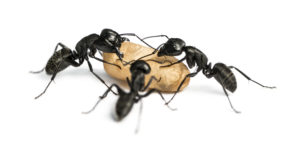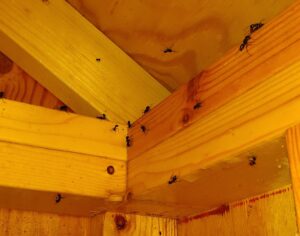Carpenter Ant Season
What are those big black ants?

This is a question we are hearing frequently at Canton Termite and Pest Control on these warm spring days. To find out, let’s explore the world of insects with this week’s bug of the week:
The Carpenter Ant Physical Characteristics
Carpenter ants are found all over Georgia and come in two varieties, the Florida carpenter ant and the Black carpenter ant. The Florida carpenter ant is typically ⅜ to ⅝ of an inch with a shiny red head and thorax and black abdomen. This ant is generally only found in southern Georgia. The Black carpenter ant is found inland in central and northern Georgia and is our most common carpenter ant species and the one we will focus on for the duration of this article. This ant is black in color with yellowish hairs on its abdomen area and ranges from ¼ to ½ of an inch long. Size alone really cannot be used to identify carpenter ants since even within a colony, there is tremendous variance in size. Still, the large ants we see are typically the carpenter ant and are considered pests for many reasons. They do destroy wood, although they are excavating through the wood and not eating it as termites are well known to do. The carpenter ants use strong, sharp mandibles to tear through the wood in order to form galleries for nesting. Secondly, their large size makes them quite the unwelcome visitor when your home becomes their foraging site!
When and Where Will I See Carpenter Ants?
In our area of northern Georgia, we usually see carpenter ant activity beginning in May and going through the early fall months of September or October. When the weather is inhospitable, nighttime is their most active period of foraging; however, the cooler temperatures of spring and fall find more daytime activity. Still, a short time after sunset may find large numbers of ants traveling from nest to food on well-maintained paths the diligent ants create and maintain. Homeowners may see nest sites outside their homes in hardwood trees with knotholes or hollowed-out trees and stumps. Consistent temperatures and humidity are the primary focus of the ants’ survival. Unfortunately, carpenter ants are also found inside homes around high moisture areas such as leaking pipes, near the dishwasher or washing machine plumbing, or in crawl spaces. Wall voids, hollow doors and frames, or even wood shingles and moisture-damaged house eaves have been known to attract the carpenter ant. Basically, they are attracted to high humidity and protected spaces that offer a safe haven for the colony.
Why Do Carpenter Ants Chew Wood?
We have already touched on this subject, but the carpenter ant is chewing the dead wood in order to create or expand their galleries for the colony to survive and thrive. There inside the colony, they are safe from the elements and their enemies such as woodpeckers, bats, and mantises. Also, as stated before, the carpenter ants depend on a humid and temperature-controlled environment so creating these wood galleries is their best option for protecting themselves.
How Do I Find the Carpenter Ant Nest?
Of course, finding the nest is important if we want to get rid of the infestation, and this is where the professional is best suited to quickly and efficiently solve the problem. After all, if you can’t find the source of the pest, you can’t protect your home from the pest. It is possible to have foraging carpenter ants inside the home temporarily before finding their way back outside to the nest. Outside the home, carpenter ants are usually spotted by either identifying their maintained trails to the source or finding the sawdust-looking shavings that are found in piles next to the nesting area. For example, an infested tree hole base will have wood debris present from their chewing efforts and perhaps discarded parts of dead insects that have been brought to the nest for food. At times, the homeowner may actually spot lines of ants making their way up and down the trunk of the tree to the trail itself and be able to follow them to their foraging area. If the ants are believed to be inside a home, then the professional will know to look for water-damaged areas that are encouraging the ants to come in and stay a while.
What Can I Do About a Carpenter Ant Infestation or Prevent an Infestation?
If your home has a carpenter ant infestation, the first thing to do is find the nest. This can be difficult and time-consuming without the experience of a professional. Once the source has been found, baits are typically used in the treatment of the colony. The bait is placed in the pathway of the foraging ants, who then take it back to the colony to distribute and thereby eradicate the whole group. However, as with all pests, it is always better to prevent than to cure. There are a few things homeowners can do to proactively discourage a carpenter ant infestation. If there are trees or bushes close to the home, it is a good idea to cut those back away from the home to discourage “bridging”. Bridging is what occurs when pests travel from vegetation such as tree limbs to the home and create a foraging trail that leads them directly into your living space. Another important prevention method is to ensure you have no water-damaged areas or leaking pipes. Attic vents, dishwasher and washing machine plumbing, sinks, and chimneys are common problem areas in a home. Remember, the ants are looking for a high-humidity area so water is a big draw.
Because carpenter ants are constantly excavating through wood, it is a distinct possibility that an infestation will cause damage to the structure of a home. For that reason, it is important for Georgia homeowners to be proactive in protecting their homes from carpenter ants. Canton Termite’s staff is knowledgeable and experienced in dealing with the problem of carpenter ants.
Give us a call today to learn more about how we can keep you pest free. 770-479-1598
By:Robin
